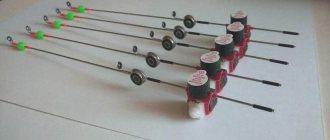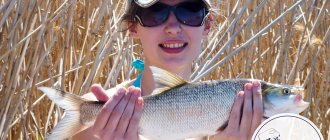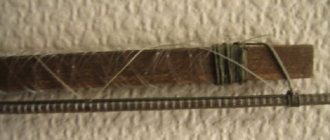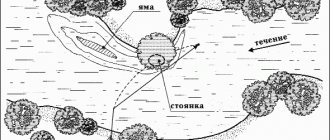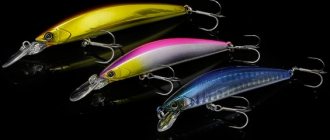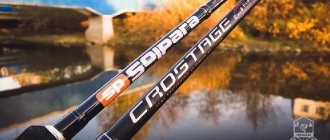What is mormyshing
Jig fishing - fishing with jigs, but using a spinning rod. Another name for the method is nanojig, because instead of a jig, a light jig head is used. Its weight is about 1 g. You can catch white fish and fish of predatory species from a boat with a short rod or a long rod from the shore. This fishing method differs from other methods in some advantages:
- Every day and in any weather you can have a good catch. Even when there is no bite, the jig tempts the fish to bite.
- You can catch fish of different sizes: roach, rudd, crucian carp and predators of various breeds.
- The gear is light and compact. You can have them with you when traveling.
- Jigs are sold in large quantities in stores. Their prices are very affordable. If desired, they are easy to make yourself.
The disadvantage of this method is that the main prey travels in packs and is small in size. Large specimens are rarely caught.
DIY spinning rod for jig fishing
It is not necessary to buy a spinning rod for jig fishing - you can make it yourself. This way you can try this fishing method without having to spend a lot of money. If you approach the issue thoroughly, you can successfully fish for more than one season .
To make such a spinning rod, you will need:
- the first and second legs of a fly rod with a super-soft tip, which is called whalebone;
- pass rings or wire for their manufacture;
- reel seat.
To connect two elbows with a plug, you need an insert that can be removed from an unnecessary old Soviet-style fiberglass. You can also cut off the handle with the reel seat. They need to be glued to the second knee of the fly rod. You also need to equip it with passage rings. You can buy them in a store or make them yourself from suitable wire. In the second case, the inner surface must be carefully polished so that the fishing line is not damaged when passing through them. The rings need to be glued to the upper and lower knees.
In what seasons is mormyshing most effective?
Mormyshing is effective in late autumn. It gets cold - this weather is favorable for catching predatory fish. In winter you won't need a spinning rod. It is enough to take winter fishing rods with you. They take maggots and bloodworms. Other times of the year are more productive. It is good to catch fish with a jig in early spring: the spring catch is characterized by the fact that the fish wakes up after hibernation and goes to spawn. After spawning, it remains to feed near the shore.
In summer, the fish become active and move away from the shore. By mid-summer you need to look for it at a great distance from the coast. In autumn, it gradually goes into the pits for the winter. Mormyshing in November is already less effective.
What kind of fish can be caught with a jig?
The most likely catch is a perch up to 100 g in size. It bites on a cut made of edible rubber and attached to a hook. There are also roaches of the same size. But large fish also often bite.
Among the large specimens you can find rudd, bream and crucian carp. Carp are less common. In many reservoirs of the country, ide, bleak, and dace are caught using nanojigging. You can catch ruffe, pike perch and pike using jigs for jigs as by-catch.
The refinement of fishing technique can be compared to the work of a virtuoso violinist. Beautiful sound requires hard work and mastering the basics of craftsmanship. This also applies to fishing with your own hands using the right equipment, which can also be used to catch bream with rotan.
What kind of fish can you catch with a microjig?
Most spinning anglers believe that when fishing with a microjig, they catch mostly small fish, and this is true, but in addition to them, they often come across quite worthy specimens. This is due to the fact that when a predatory fish is in a passive state, it does not react in any way to large baits, and small microjig baits provoke it to attack.
Perch
Perch is the main object of microjig fishing. Perch is found in almost any body of water, be it a lake, pond or river. In many bodies of water, smallmouth bass are the predominant fish.
Rotan
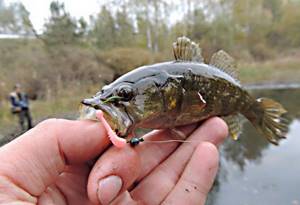
Rotan is caught very well using microjig, and fishing for rotan using microjig is carried out purposefully.
White fish
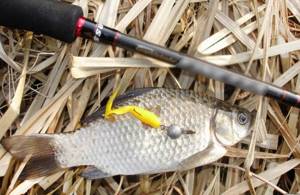
Various white fish: crucian carp, rudd, bream, roach, silver bream, ide, chub are well caught using microjigs. Some anglers catch whitefish on microjigs on purpose, but in most cases they are caught on microjigs as bycatch when fishing for perch.
Pike
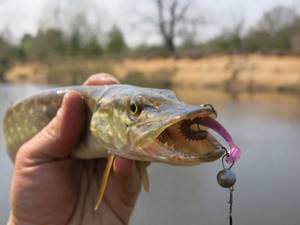
Pike is not specifically caught using a microjig; it is sometimes caught as bycatch when fishing for perch, but even more often, during perch fishing, it simply cuts the line with its sharp teeth. Therefore, if you are fishing in a reservoir where there is a high probability of catching pike, you will have to use a thin metal leash.
You may be interested: Jackall Tiny Fry is not an easy fryer
Zander
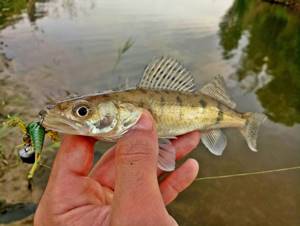
Pike perch, like pike, is not specially caught for microjigging, but it is caught as bycatch when it goes out to hunt for fry in shallow waters.
Tackle for jig fishing
Fishermen are accustomed to using a variety of gear to hunt large and small fish of different breeds. A good tackle for jig fishing is a spinning rod with ultralight dough. Practice has shown that it is most convenient to use a weight of 8 g.
To the spinning rod you need to add a jig with a hook, tied to a fishing line wound on a reel. You can get by with a budget jig fishing reel taken from other gear. General equipment includes: fishing rod, fishing line and bait.
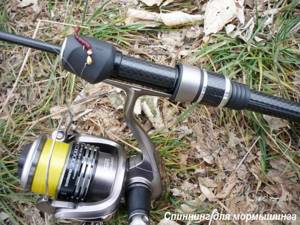
Spinning rod for jig fishing
Catching predatory fish with a jig, or nanojig as it is often called, is gaining increasing popularity among anglers. Many ordinary fishermen and sportsmen are increasingly resorting to this type of fishing. And it’s no coincidence:
- Fishing with a jig is very effective. It is this type of fishing that allows you to stay with your catch all year round, under any conditions. Even during a period of complete lack of biting, you can always tempt passive fish to bite. And the sheer variety of fish that can be caught with a jig is very large: you can often catch fish that are unusual for a spinning angler, such as rudd, ram, or even a completely non-predatory crucian carp.
- This type of fishing is highly intelligent. Success directly depends on the correct animation of the bait. It is in this type of fishing that the spinning rod plays the role of a kind of nod, and allows you to perform a completely varied retrieve. In addition, the very variety of types of jigs and various miniature, often homemade silicone baits allows you to make this fishing as creative and varied as possible.
fishing line
The fishing line or cord is wound onto a reel, which should weigh 170−200 g. The fishing line is placed on an inertia-free reel without tension. Convenient sizes are 1000 or 500. Choosing fishing line is more difficult.
Monoline and braid have both advantages and disadvantages. The cord has high strength and small diameter. But he is sinking quickly. Its cost is high. Small fish may feel the cord and spit it out of their mouth. This doesn't happen with fishing line.
A fishing line with the same diameter costs much less, but its quality is worse. The middle position between fishing line and cord in terms of cost is occupied by nanofil. But it is not resistant to mechanical stress and often breaks when it comes into contact with stones at the bottom of the reservoir. The best option is fluorocarbon and monofilament line with a thickness of 0.08-0.16 mm. Its length on the reel is 100−150 m.
Jigs
The weight of the jig should be no more than 1 g. It is equipped with a sharp and small hook, which allows you to catch fish of various sizes.
Jigs can be made of lead or tungsten. The second option is preferable because it provides greater mass with small volumes. This equipment allows you to make longer casts with maximum accuracy.
To sink smoothly to the bottom, you need to choose a very light lead bait. Jigs on a spinning rod made of round or flat-oval plastic, painted red on one side, have good catchability.
For jig fishing, it is worth purchasing baits with an eye, which makes their use more convenient. Suitable jigs for catching perch are shiny or multi-colored; for catching white fish, they are dark. It is recommended to stock up on equipment of various shapes and sizes, which allows you to achieve good results under different fishing conditions.
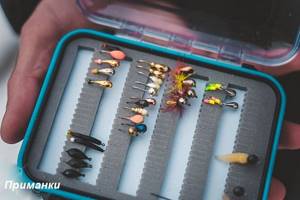
When jig fishing, you also need to select hooks. The choice depends on the bait and the type of fish being hunted. The following hooks are recommended: for roach - No. 3.5-5, for perch - No. 4-6, for bream - No. 5-7.
Lures
Here every fisherman can give free rein to his imagination. Today on the market there are many minimum-sized lures that can be safely cast on a jig. One worm can be cut into 2 parts and you will get two good baits. And so on. Interestingly, old, worn-out baits can be used for jig fishing.
To do this, they should be cut into strips, which will serve as bait. The so-called slicing perfectly attracts both predatory and peaceful fish.
Fishing with a spinning rod using a jig is a fun and effective way of fishing. During heavy fishing pressure, it allows you to always remain with your catch. And at competitions, jigs often outperform even classic jigs.
Reflection on mormyshing
Friends, hello! Today I will talk a little about jig fishing and try to share my experience gained over several years of fishing this way.

For those who don’t understand what we’re talking about: jig fishing is a method of casting with a spinning rod in open water, in which an ordinary winter jig acts as a weight for silicone bait. This is no longer a microjig or even a nanojig, this is the height of “nerdiness” in an ultra-light spinning rod, when the length of the bait rarely exceeds one inch, and the weight of the “projectile” delivering the bait to the fishing spot ranges from 0.18 to 1 g.
Many fishermen fundamentally do not understand and do not recognize mormyshing as a new religion, sighing sympathetically at the sight of another adherent, and often twirling their finger at their temple. I came to jig fishing through coastal fishing. In the regions, successful mastery of this fishing technique is almost always the key to a good performance. Mormyshing allows you to catch a lot of active fish, and also helps to tempt fish that are in a “comatose state” to bite. However, it would be a mistake to believe that only athletes use jigs; Every year more and more ordinary fishermen become interested in this type of fishing.

Whatever one may say, mormyshing has many advantages. For example, accessibility. Within the city limits, you can stop by for an hour before or after work at your native reservoir and, as they say, set your teeth on edge. And in general, you can fish in any “puddle” where there is a perch. Or the sharpness of sensations. Pulling out a hundred-gram perch with ultra-light tackle gives about the same emotions as catching a kilogram pike with an ounce spinning rod.

Here we also note the species diversity of the caught fish. In addition to perch, the jig often catches non-predatory fish - lively roach and rudd, bream, chub and other white fish, the fishing and capture of which will certainly give you positive emotions.

What about compactness? In terms of gear, you will need a rod, a reel, a box of jigs and heels of different baits for experiments. That's all. You are always light, and this, on the one hand, adds comfort when fishing, and on the other hand, reduces the time for getting ready to a minimum.
I think I won’t be mistaken if I say that the main argument of those who do not accept jig fishing is: “Why even catch such a small thing?!” The answer is simple: “For fun!” For many, catching fish in a frying pan is no longer an end in itself, and modern ultra-light tackle allows you to enjoy fishing for even a small perch.

To try your hand at jig fishing, you need the right gear. I don’t want to puff out my cheeks and pretend to be an expert, so I won’t try to describe in detail all the types and subtypes of fishing rods and other gear used in jig fishing, but will limit myself only to my experience. The same applies to the fishing technique described below.
Most often, fishing rods designed for catching pond trout are used for jig fishing. They are distinguished by a slow (regular) action, which makes it easy to swing the jig. Perhaps the most famous trout jig rod is the Graphiteleader Bellezza 602XUL. An old one, long removed from sale, but has not lost its popularity to this day. I had this “squirrel” for some time. I can’t say anything bad about her, but I can’t say much good either.

Probably because for jig fishing I prefer a different type - microjigging spinning rods with a moderately fast action and soft insertion, which, in general, defines the whole jig game. As for me, they are more predictable in control, their wiring is set faster and is better controlled. The most vivid impression I got of a spinning rod of this type was the Shimano Soare Xtune S709ULS. Long, light, responsive and... Expensive and elusive to buy.

Now I only cast jigs with inexpensive spinning rods. This is the old Black Hole Rimer S-632UL-ST and the newcomer to the arsenal, the Norstream Areator 582XUL.
A jig reel should lay thin lines well, not throw loops, have a well-adjustable brake, and weigh as little as possible; It's good if it has a low gear. Of those that I have owned, I can without a twinge of conscience recommend Shimano 17 Soare CI4+ C2000SSPG. The only drawback of this reel is its rather high price. Among the more affordable alternatives, you can consider its cheaper version Shimano Soare 13 BB C2000SSPG. The only fundamental difference between them is in weight: CI4+ weighs 160 g, and BB-shka - 190 g.

It so happened that when fishing with jigs, I use exclusively braided cords, ignoring monofilament. The main requirement for a thread concerns its diameter: the smaller it is, the further we can cast our tiny bait. The round cross-section, smoothness and softness of the braid also contribute to increasing the casting distance. Among the relatively inexpensive ones, I can recommend the YGK G-Soul Upgrade PE X4 #0.2 or the Duel Armored F+ Pro series, whose diameters start at 0.04 mm (2.5lb). I didn’t go to extremes and use 0.05 mm (3lb) braid with a breaking load of 1.5 kg. Don't be alarmed by these modest breaking load values. Believe me, you don’t need more for mormyshing. By the way, regarding the Duel Armored F+ Pro cord, before purchasing, I advise you to watch a YouTube video on the Spin&Cast channel, which is called Great review of the Duel Armored F+ Pro (you can start from the 14th minute). The fact is that the Japanese have released as many as 8 lines under one name: some are stretchable and better suited for trout fishing, others are better suited for rock fishing. You can distinguish them by the color of the letter on the packaging. For example, the rockfishing series, which, in my opinion, is best suited for jig fishing, has a red letter on the packaging.

Regarding the fluorocarbon leash. It definitely should be. When fishing with jigs, we use lines so thin that they easily break on any underwater obstacles we encounter. And whatever one may say, the FC is visible worse than the cord in the water, which means the fish will treat the bait with greater confidence. The breaking load of the leash used should be less than the breaking load of the cord, then in the event of a break, only the bait will have to be retied. At all times I tie the leash to the cord using a double uni knot. I use Sunline fluorocarbon: either Small Game Leader FCII or Siglon FC.

As for jigs, at the very beginning of my journey I bought handfuls of a variety of inexpensive jigs of all colors, shapes and shades in retail stores. Almost all of them had one common negative feature - dull hooks made of thick wire. As a result, I sold most of them, leaving a few for fishing in conditions of frequent cliffs. A good jig is distinguished by maximum weight with a minimum size and a sharp hook made of thin wire, which itself sticks to the fish. I prefer the Tula jig in the form of a drop. It is relatively inexpensive and quite high quality. The most popular weights are 0.3–0.4 g. I prefer dark matte colors to bright ones.

There are many well-proven jig baits on the market. The most famous, perhaps, is the pop Berkleve bloodworm, which, by the way, I don’t have enough stars from the sky. Maybe because you don’t want to tinker with a jar. The second most popular are the inch-sized "javastik" and handicraft Baby Rockfish. Next, Fishup Tanta, Crazy Fish Cruel Leech and Lucky John King Leech lined up in a single row. Favorite colors are marsh and purple.

Now about fishing. Everything that I will describe further relates to a greater extent to sport fishing for perch on the reservoir, since most of my jig fishing is associated with it. Although you can really fish anywhere (river, pond, lake, swamp) where there is fish, and jig fishing will most likely delight you with bites.

Until recently, I had one working wiring - a high-frequency, low-amplitude “mormodoch”, set by inserting a spinning rod. In this case, the bait goes in the lower horizon, but more often does not touch the bottom. Last year I liked another wiring option. It is somewhat similar to “black wires” (Google it if interested), only even more “unhinged” and wide-amplitude. It’s difficult to describe this wiring, but from the outside it may seem that I’m not fishing, but playing around like a child, just shaking the spinning rod as hard as I can. No matter how strange it all may seem, sometimes it works very well. Once this wiring brought me a silver medal in the individual competition at a competition.

Now a couple of observations that I think are important. While fish are often caught underfoot, casting distance is sometimes critical, especially when fishing pressure is high—such as during competitions. I also believe that when retrieving, the action of the bait should be repeatable and go without failure. I noticed that when fishing without failures, the perch bites me much more often.

Well, be sure to take polarized glasses when fishing. With them, you will not only quickly find the concentration of fish and know what your bait is doing underwater, but you will also see with your own eyes (if you’re lucky) a few bites.

Fish!
Love fishing! Share
Reels. Does size matter?
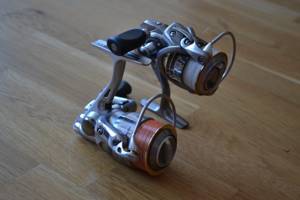
Reel for jig fishing
You can hear many opinions regarding jig fishing reels. Are various aspects of choosing this element of gear discussed? But what is really important to know when choosing a reel?
Firstly, it must lay thin cords (line) perfectly and not throw loops when casting the lightest weights. This is the main criterion.
As for the weight of the reel, many agree that it should be extremely small. They say that a light-weight reel balances well with an elegant trout spinning rod. But there are also amateurs who specifically use a heavy reel, which slightly speeds up the rod blank and the wiring becomes more vicious. There are few such fishermen, but they still exist.
What about the standard size? In fact, you can use a 2500–3000 size reel, as in microjig, in order to increase the casting distance. But if you decide to use a light reel, then at that weight and size they cost a lot. When fishing with a jig, the use of size 1000 is justified. Here the casting distance is not so critical, although there are rare exceptions. Lightweight and inexpensive 1000 or even 500 will do the job perfectly.
Microjig
Microjig is the bottom step of classic jig fishing. The weights used are usually from 1 to 3 grams, with baits ranging from 0.8 to 1.6 inches.
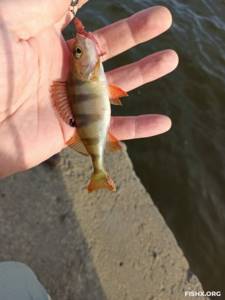
There are no tricks to fishing with microjig. The same fishing techniques, retrieves, tactics and strategies are used as in a regular jig. The rods used are usually parabolic rods, the so-called “noodle” or “snot” rods. Typically, stick lengths of up to 2.4 m and a test of 0-3 grams are used. To reduce the size of the load, tungsten weight heads are actively used in microjig.
How to choose the right fishing rod
As already mentioned, a special spinning rod must be chosen. The product should be such that you can not only cast the bait as far as possible, but also be able to easily play with it. Experienced fishermen advise paying attention to the ultralight system, which has a test value of 0.5 grams.
Important! The rod should be sensitive, comfortable, soft, but at the same time strong.
Only with such a detail a good catch will not be long in coming.
There are a great many models that have the characteristics described above. However, despite this, choosing something suitable can be very difficult. The reason lies precisely in the abundance of different names, which are insignificantly disconnected from each other, but still. Most professionals advise taking a closer look at a trout rod. These include products labeled SXUL, XUL, XXUL, SUL, which have a low test value. Thanks to such products, you can fish with baits weighing less than 0.5 grams.
Slow and parabolic action is what the above-described fishing rods can boast of. This feature allows you to cast jigs as far as possible with extreme ease, and also play with the bait without any difficulty. Due to the softness of the tackle, you can be sure that not a single fish will fall off the hook.
As for the shortcomings, there are some. Among these we can note inaccuracy during casting. However, with practice, this will not be a problem, because the fisherman will get used to throwing the jig where he needs it.
Today there are several models for nanojig, which are in great demand.
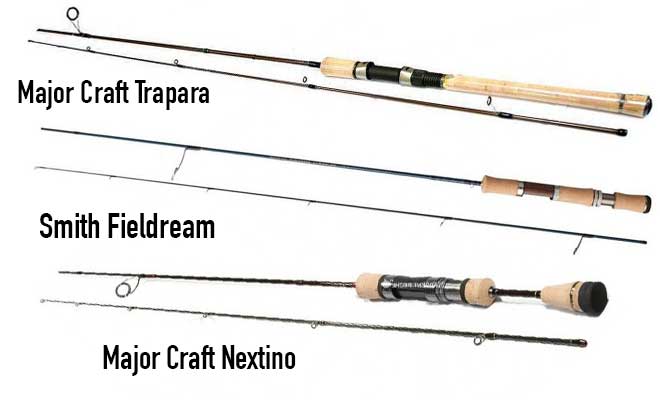
It must be said that there are many more elements on sale and they are all of high quality and reliable.
Spinning equipment
Having figured out the spinning rod with a jig, you can move on to choosing equipment. The best place to start is with a reel. First of all, you need to think about the balance of the tackle.
Considering that the fishing rod has a slow action, you need to choose a reel that will match the weight. It is advisable to take an element that weighs over 180 grams. If we talk about sizes, then a 2000 reel is most suitable for the presented rods. Some fishermen pay attention to the 500th or 1000th, but you need to understand in this case that you won’t be able to cast the jig far. At the same time, a large size will lead to the tackle being unbalanced. If we talk about the manufacturer, then there will be no problems with him. The best are Daiwa and Shimano. They are in special demand. Considering that the parts from the companies described above are expensive, you can purchase something cheaper. Fortunately, there are enough products on today’s market.
Important! Whatever reel you buy, you need to take proper care of it.
Rating of the best
Currently, in fishing stores you can see a large number of special spinning rods designed for jig fishing. In this review we will look at the most popular varieties among consumers.
Teton TTS-622SUL
This model for jig fishing is produced by the Chinese company Kuying. The sample (in its structure) belongs to the parabolic type. It has high strength and rigidity, and comes with a convenient small hook. When loaded, the form is completely immersed in water, and the load goes into the butt. The bending curve does not have sharp changes, it is quite smooth. To produce this spinning rod, high-quality Japanese rings are used. In addition, the product boasts a high-precision connection. For manufacturing, a special carbon fiber is used, which is produced by the Japanese manufacturer Toray. The handle of the model is made of durable French composition-type cork.

Azura Olivia 632UL
This model can also safely be considered among the top best for jig fishing. Carbon fiber is used to make this spinning rod. Often they use very small baits, weighing less than one gram. The handle of the product is created from a high-quality cork base. The model is equipped with a special Sea-Guide system. The total length of the sample is 1.9 meters, it includes two sections. The product is equipped with lightweight, durable rings.
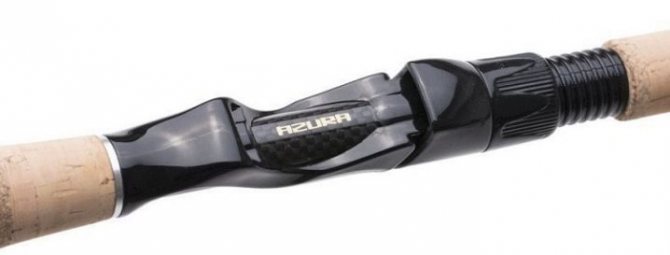
Major Craft Trapara TPS-562SUL
This spinning rod model belongs to the group of budget options; it is produced by the Japanese company Major. The whip is made from a graphite base. In addition, a special Nano Carbon material is used for production, which is distinguished by a special level of flexibility, strength and low weight. The product has a rather soft parabolic structure. The device is equipped with five durable guide rings for fishing line. Moreover, each of them is created with an internal insert, which is made of a silicone base. It provides better glide.
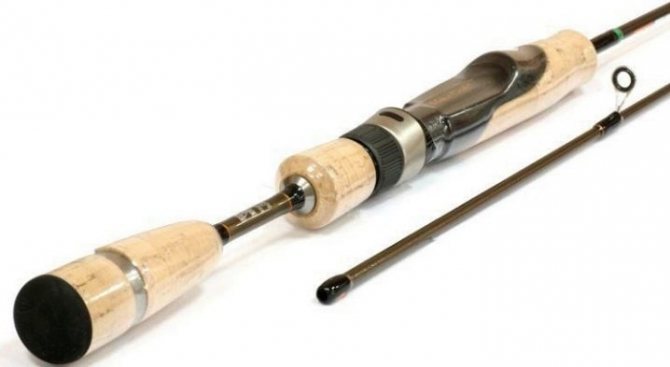
All joints are additionally protected using a special casing made of fiberglass. Major Craft Trapara TPS-562SUL has the most user-friendly plug design , which is characterized by a fairly large working part, low weight of the rod, and versatility of all fastenings. This spinning rod can be used to install almost any type of attachment. In the basic series, this model can be additionally equipped with a retractable telescopic part.
Such varieties are equipped with a closed drive, inside of which there is a special support-type mechanism with a locking system and special lubrication.
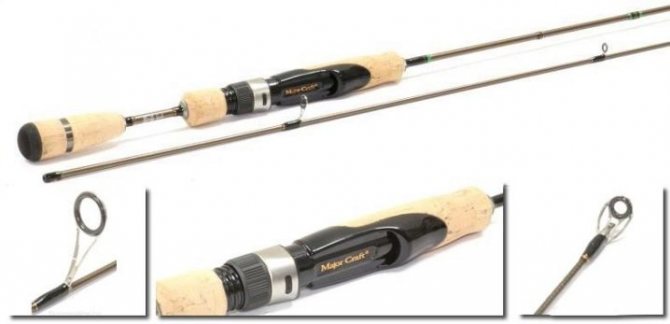
Fishing ROI Butterfly 602XUL
This spinning rod for jig fishing has a convenient plug-in design. It has a medium rod action. The product is made from high quality carbon fiber. The handle is made with a foam layer. The model includes only two sections. Its length is 1.8 meters, and it can be easily folded, in this form its length will reach only 95 centimeters. The sample weighs only 91 grams. The rod is well balanced, the spinning rod has a special level of sensitivity, rigidity, and strength. The device provides longer casting and allows complete control over the fish.

Examples of spinning rods
Considering all the requirements for spinning rods for jig fishing, it is clear that it must be of a very high class of performance and cannot be cheap. However, among them there are both more expensive models and more affordable ones. Here are some examples:
Major Craft Trapara TPS-562SUL
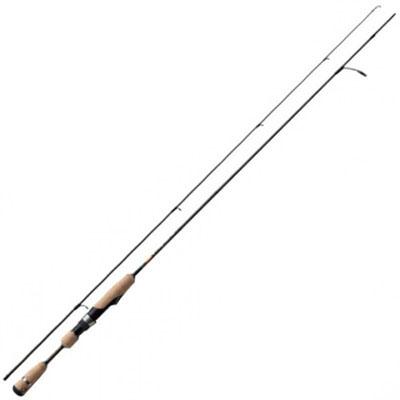
It belongs to the SUL (Super Ultra-Light) class. Its parameters: length 173 cm, weight 92 g, test 08 - 3 g. Has a slow build.
A good rod, which is quite suitable for frequent use when fishing with jigs in the summer.
Major Craft Nextino (area category) NTA-602XUL
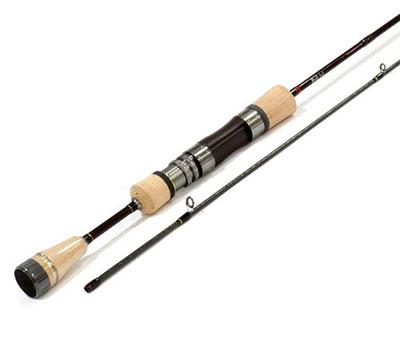
It has the following characteristics: length 183 cm, weight 69 g, test 0.5 - 2 g, parabolic action.
It is intended for experienced jig fishing enthusiasts.
Graphiteleader Calzante EX GOCAXS 732UL-T
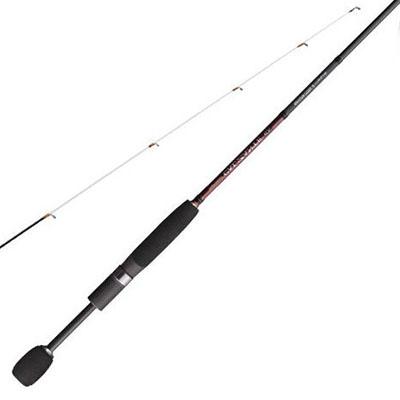
Its data: length 221 cm, weight 90 g, bait test 0.6 - 8 g. A very high quality blank that, with proper care, will withstand frequent fishing trips.
It is quite suitable for experienced spinning fishermen and sports fishermen.
How to do it yourself?
If you don’t want to buy a spinning rod at a fishing store, you can make it yourself. Let's look at a step-by-step diagram of how to assemble such a fishing device. The primary thing in this matter is the selection of a fishing rod. It is necessary that it be as light as possible, but at the same time durable and strong, otherwise the form will simply break during the hunt. The test should be minimal (range 0.5-5 g). The structure must be of a parabolic type. You should not select a fishing rod with a fast action; despite its high level of sensitivity, it is not suitable for jig fishing.
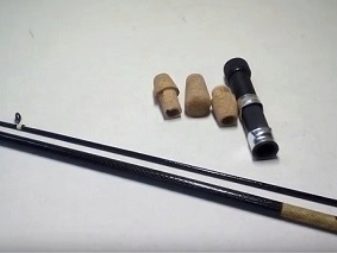
The total weight of the form can be 100–130 grams. For a homemade product, the best option would be a design designed for trout fishing. Then you should pay attention to the choice of the float part with the jig. Purchase these items in advance, which are relatively light in weight (a few grams). Attention should be paid to the selection of fishing line. Such a spinning rod must be equipped with a strong cord or monofilament thread.
At the same time, make sure that the fishing line is laid as neatly and correctly as possible in the spool. The result of fishing will largely depend on this.
Remember that in the process of assembling a spinning rod and connecting parts, the balance of individual fishing gear plays an important role, so you should carefully select all the components, taking into account their dimensions and weight. As for reels, it is better to give preference to the inertia-free variety. It is recommended to purchase this part separately; the best option would be a coil from a well-known global manufacturer.
Next, a jig is selected. It should be equipped with a small and sharp hook. Tungsten models are predominantly used, as they provide large mass with small volumes. This type of equipment allows for long casting. For spinning, it is better to purchase baits with an eye, this makes their use most convenient for the fisherman. Most often, shiny and colored options are purchased. If you are going to hunt white fish, then preference should be given to dark samples. Don't forget to make different wiring on the spinning rod. They can be of two types: along the bottom and in the water column. The first option allows you to move the jig along the bottom in gradual jerks. The second option involves “playing” the tips of the device.
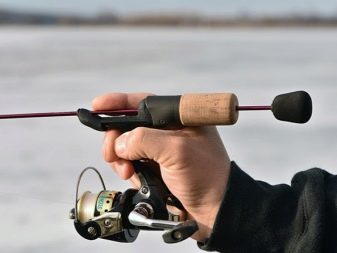
What is the difference between summer and winter mormyshing?
Mormyshing in winter and summer are different from each other. Summer jig fishing is no less interesting than winter fishing. In summer you should take a heavier jig. This is done due to the casting of the tackle at some distance from the fisherman. When fishing from a boat, use a short winter fishing rod. The fishing line is wound on a reel or reel, and a jig is attached to its end.
In appearance it should resemble live food. When fishing, the jig is located at the very bottom or slightly higher. In spring, the fish are in shallow water, in summer they go deeper, and by autumn they occupy places in pools and holes.
In summer, when fishing from the shore, a fisherman stands in the water, so he needs special clothing and shoes. In still water of ponds and lakes, it is recommended to cast a jig, then pull it towards you or drag it jerkily along the shoreline. The jig rises up slowly, with pauses. After each pause, you should lower it a little, then raise it again. During this game, you can tap the rod with your finger at the place where the reel is attached. This will give additional vibrations to the tackle.
If you put live bait on the hook, you can catch a large predator in the form of a pike or perch. During the current, keep the jig constantly near the bottom. The casting is done upstream. When playing, it is not recommended to lift the jig high from the bottom.
When fishing with baitless tackle, you need to maintain a high frequency of its oscillations and attach a light metal hook to the fishing line. You can put cambrics made of multi-colored PVC pipes on it.
When winter fishing, the knots and baits are the following: a short fishing rod, a whip, a fishing line with a jig attached to it, a nod. The latter serves as a bite alarm. The float and sinker are missing. Jig fishing in winter requires different types of jigs. The most popular: klopik, Ural, droplet, shot, oatmeal, etc. Over time, each fisherman develops his own favorite jigs.
Summer jig fishing
The main feature of summer spinning is that the bait is not allowed to fall to the bottom. Retrieving begins when the bait drops to the middle depth of the reservoir. In this case, the jig is driven slowly, making characteristic oscillations with the spinning rod.
It is recommended to diversify the wiring: make short or long pauses in movements, make sharp explosions from the bottom, give slight vibrations.
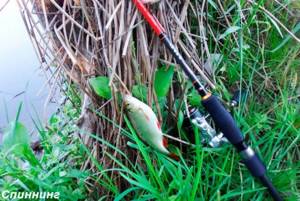
When fishing in summer, the jig resembles a fly fishing fly. It is made from natural and artificial materials. Such baits sink to the bottom longer, which is especially convenient when catching white fish.
Features of fishing techniques
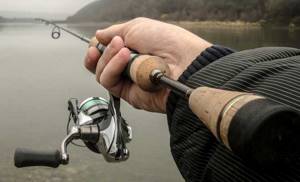
Fishing with a spinning rod using a jig involves a large number of retrieves. Each angler decides for himself which one to use. If you want to catch white fish, then the retrieve should be slow; if you want to catch a perch or other predator, then it should be energetic.
In principle, all techniques are divided into two types:
- Wiring along the bottom. In this case, the bait moves jerkily, changing its amplitude each time.
- Wiring is at an average level. In this case, the tip of the rod constantly plays, attracting new fish.
What type of wiring to use is decided individually. Sometimes it happens that one thing works effectively on one body of water, but something completely different on another.
True, there are types of games that have proven themselves well when it comes to fishing for one or another type of fish. So, for example, if you want to catch a “minke whale,” you need to alternate sharp jerks with pauses of several seconds. At the same time, it should be remembered that the predator is often at the bottom, so wiring is done accordingly in this part of the reservoir.
As for white fish, on the contrary, it lives in the middle layer of water. Playing with this fish with a jig should be leisurely, with long pauses. Otherwise, neither roach, nor bream, nor the like will swim even ten meters closer to the bait.
So, you have decided to buy a spinning rod for jig fishing.
It should be noted that manufacturers of spinning rods do not produce models specifically for this type of fishing. Therefore, you should first of all pay attention to specialized trout spinning rods with the lowest test.
It was noted that in this particular type of fishing, the modularity of the blank and the high technology of manufacturing the rod are not so important. This type of fishing does not require long casting and the highest sensitivity. The main thing is that the spinning rod can set the correct amplitude of oscillations of the jig, and it is on this factor that the fisherman’s catch directly depends. So even a budget model such as Major Craft Trapara or Aiko Troutex copes well with this task.
Fishing with a spinning rod using a jig is very exciting and exciting. And, although the object of fishing most often becomes a small coastal fish, you can be sure that such fishing will give you a lot of positive emotions and will be remembered for a long time.



